中西方教育体制差异英文课堂
- 格式:ppt
- 大小:3.65 MB
- 文档页数:30
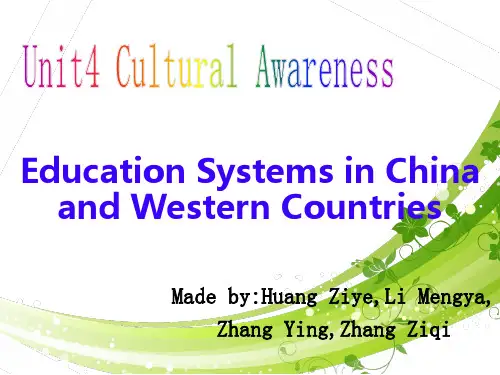


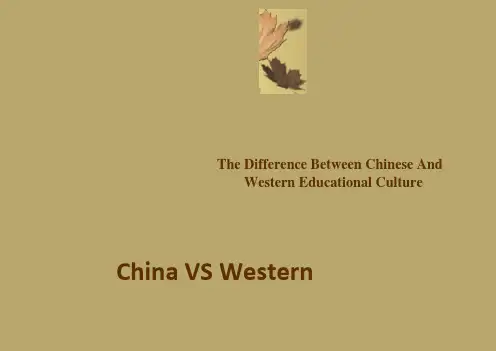
The Difference Between Chinese AndWestern Educational Culture China VS Western尙〔.difference of familv educationDiffere nee2.difference of school education1Difference between china education and western educationEducation is not the preparation for making their living, but for survivalYr The education'sgoal is for making their living, for honor Emphasize" The Learn Education."ChinaWestern Countriesreputation ineducation the childCare about the凸China Education method匕1.Emphasize mechanical memorizi ng.2」f the book is readhundreds of times,its meaning isshown naturally^WesternCountries 魂1.Emphasize thechilcTs” power ofunderstanding." 樺2.Seeking theknowledge from lifeand nature.Education inFj Chinal.Earning money tosupport ongs familyand managing thewealth are adult's* matter.・Try every means to $ satisfy the children 1with money・managing money璋Western Countries# l.Teach the child take theplans for budget items,learn to spend moneyreas onably.弊2・Encourage the childto work outside to gain income by themselves.American children in class Chinese children in classDifferences of schooleducationThe relation between teachers andstudentsIn America teachers are no longer authority, meanwhile students don't have to carry out every instruction from their teachers, most of them have their thoughts, they may most questions and challenges toteachers・如n chin可the relaUonship between teachers and students can be quite formal.# We are taught since the first day when we go to the kindergarten that we should sit up straight and obey all the disciplines. in class we seldom challenge the teacher's ideas.Summary凸l.Westerners believe in individualism, and Chinese believe in collectivism.匕2.The western culture has the freedom to express affection freely,whereas the Chineseculture is puritanical.蜉3.The Chinese believe in relationships, and searching for inner bliss and happiness through meditation.鏗4.The western culture believes in a materialistic approach, and has a pragmatic and emotional attitude・。


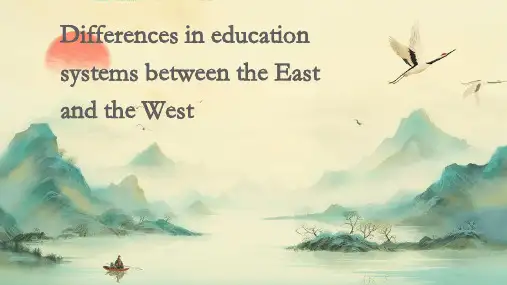
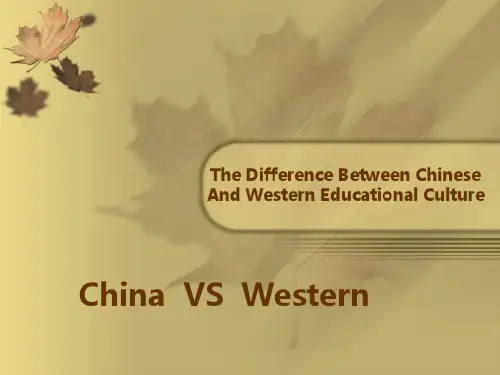
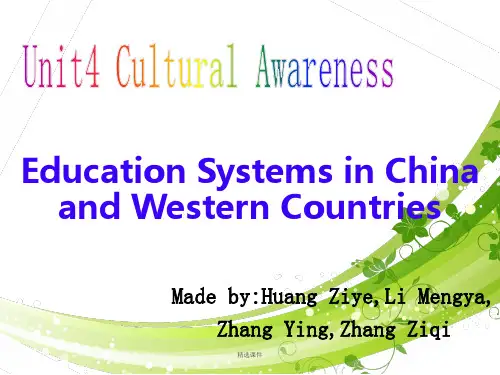


中西方课堂的差异英语作文In Western classrooms, students are encouraged to express their opinions freely and engage in discussions with their peers. Teachers often act as facilitators rather than authority figures, fostering a collaborative learning environment.In contrast, in Chinese classrooms, students are expected to listen attentively to the teacher and follow instructions without questioning. The focus is on rote memorization and mastery of content rather than critical thinking and creativity.Western classrooms often incorporate group work and projects to promote teamwork and communication skills. Students are encouraged to work together to solve problems and share ideas, fostering a sense of community and cooperation.Chinese classrooms, on the other hand, tend to be moreteacher-centered, with the teacher delivering lectures and students taking notes. There is less emphasis on collaboration and more on individual achievement and performance.In Western classrooms, assessment is often based on a variety of methods, including presentations, essays, and projects. Students are evaluated on their understanding of concepts and ability to apply them in real-world situations.In Chinese classrooms, assessment is typically based on exams and standardized tests. Students are expected to memorize information and perform well on tests to demonstrate their knowledge and understanding of the material.Overall, the differences between Western and Chinese classrooms reflect broader cultural values and educational philosophies. Western education tends to prioritizecritical thinking, creativity, and collaboration, while Chinese education emphasizes discipline, hard work, and academic achievement.。
中西方课堂的差异英语作文In Western classrooms, students are encouraged to express their opinions freely. They are often given the opportunity to engage in open discussions and debates, allowing them to develop critical thinking skills. This promotes a more interactive and dynamic learning environment.On the other hand, in Chinese classrooms, the emphasis is often on rote memorization and following instructions. Students are expected to listen attentively to the teacher and take notes. This traditional teaching method focuses more on the accumulation of knowledge rather than on fostering independent thinking.In Western classrooms, teachers often use various teaching aids and multimedia resources to make the learning process more engaging and interactive. They may use videos, PowerPoint presentations, or online resources to supplement their lectures. This helps to capture students' attentionand enhance their understanding of the subject matter.In Chinese classrooms, the use of teaching aids is less common. Teachers mainly rely on textbooks and chalkboards to deliver their lessons. This traditional approach may be seen as more disciplined and structured, but it may also limit students' creativity and critical thinking abilities.In Western classrooms, students are encouraged to ask questions and seek clarification if they do not understand something. This promotes active learning and helps students to develop a deeper understanding of the subject matter. Teachers are seen as facilitators of learning, rather than the sole source of knowledge.In Chinese classrooms, students are often hesitant to ask questions, as they may be seen as challenging the teacher's authority. The teacher is considered the ultimate authority figure, and students are expected to listen and obey without questioning. This can hinder students' ability to think critically and actively participate in the learning process.In Western classrooms, group work and collaborative projects are often encouraged. Students are given the opportunity to work together, share ideas, and learn from their peers. This promotes teamwork and helps students to develop important social skills.In Chinese classrooms, group work is less common. Students are often expected to work individually and compete against each other academically. This may foster a more competitive environment but may also hinder students' ability to collaborate and communicate effectively with others.Overall, the differences between Western and Chinese classrooms reflect cultural and educational traditions. While Western classrooms focus on fostering critical thinking, independence, and active learning, Chinese classrooms emphasize discipline, rote memorization, and respect for authority. Both approaches have their merits, but it is important to recognize and appreciate the diversity in teaching methods and learning styles.。